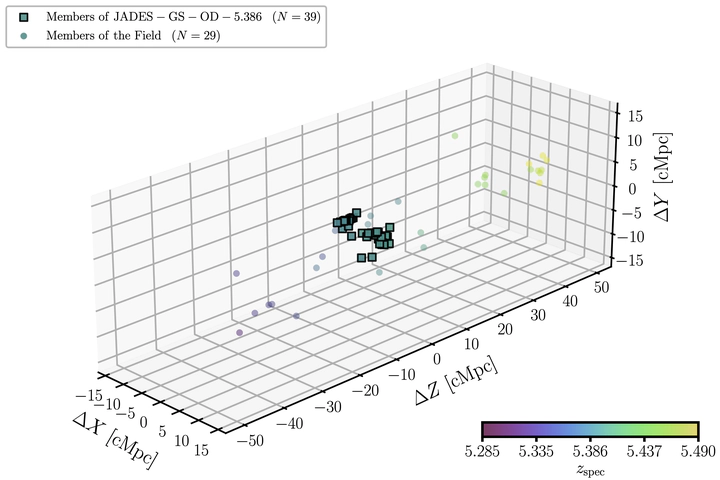Identification of High-redshift Galaxy Overdensities in GOODS-N and GOODS-S
Identification of High-redshift Galaxy Overdensities in GOODS-N and GOODS-S
Oct 3, 2024· ,,,,,,,,,,,,,,,,,,,,
,,,,,,,,,,,,,,,,,,,,
Dr. Jakob M. Helton
Fengwu Sun
Charity Woodrum
Kevin N. Hainline
Christopher N. A. Willmer
Marcia J. Rieke
George H. Rieke
Stacey Alberts
Daniel J. Eisenstein
Sandro Tacchella
Brant Robertson
Benjamin D. Johnson
William M. Baker
Rachana Bhatawdekar
Andrew J. Bunker
Zuyi Chen
Eiichi Egami
Zhiyuan Ji
Roberto Maiolino
Chris Willott
Joris Witstok
 Figure 3 from Helton et al. (2024, ApJ, 974, 41).
Figure 3 from Helton et al. (2024, ApJ, 974, 41).Abstract
We conduct a systematic search for high-redshift galaxy overdensities at $4.9 < z_{\mathrm{spec}} < 8.9$
in both the Great Observatories Origins Deep Survey (GOODS)-N and GOODS-S fields using James Webb Space Telescope/Near-Infrared Camera (JWST/NIRCam) imaging from the JWST Advanced Deep Extragalactic Survey and JWST Extragalactic Medium-band Survey in addition to JWST/NIRCam wide field slitless spectroscopy from the First Reionization Epoch Spectroscopic Complete Survey. High-redshift galaxy candidates are identified using Hubble Space Telescope + JWST photometry spanning $\lambda = 0.4-5.0\ \mu\mathrm{m}$
. We confirmed the redshifts for roughly a third of these galaxies using JWST spectroscopy over $\lambda = 3.9-5.0\ \mu\mathrm{m}$
through identification of either $\mathrm{H}\alpha$
or $\mathrm{[OIII]}\lambda5008$
around the best-fit photometric redshift. The rest-ultraviolet magnitudes and continuum slopes of these galaxies were inferred from the photometry: the brightest and reddest objects appear in more dense environments and thus are surrounded by more galaxy neighbors than their fainter and bluer counterparts, suggesting accelerated galaxy evolution within overdense environments. We find $17$
significant ($\delta_{\mathrm{gal}} \geq 3.04$
, $N_{\mathrm{gal}} \geq 4$
) galaxy overdensities across both fields (seven in GOODS-N and $10$
in GOODS-S), including the two highest redshift spectroscopically confirmed galaxy overdensities to date at and (representing densities around $\sim 6$
and $\sim 12$
times that of a random volume). We estimate the total halo mass of these large-scale structures to be $11.5 \leq \mathrm{log}_{10}(M_{\mathrm{halo}}/M_{\odot}) \leq 13.4$
using an empirical stellar mass-to-halo mass relation, which are likely underestimates as a result of incompleteness. These protocluster candidates are expected to evolve into massive galaxy clusters with $\mathrm{log}_{10}(M_{\mathrm{halo}}/M_{\odot}) \gtrsim 14$
by $z = 0$
.
Type
Publication
The Astrophysical Journal, Volume 974, Issue 1, id.41, 17 pages
High-Redshift Galaxies
High-Redshift Galaxy Clusters
Galaxy Formation
Galaxy Evolution
Early Universe
Authors
Astrophysicist | Evolving Universe Postdoctoral Scholar | Science Communicator
Related
- The JWST Advanced Deep Extragalactic Survey: Discovery of an Extreme Galaxy Overdensity at z = 5.4 with JWST/NIRCam in GOODS-S
- Earliest Galaxies in the JADES Origins Field: Luminosity Function and Cosmic Star Formation Rate Density 300 Myr after the Big Bang
- JWST NIRCam + NIRSpec: interstellar medium and stellar populations of young galaxies with rising star formation and evolving gas reservoirs
- JADES: Rest-frame UV-to-NIR Size Evolution of Massive Quiescent Galaxies from Redshift z = 5 to z = 0.5
- The JADES Origins Field: A New JWST Deep Field in the JADES Second NIRCam Data Release